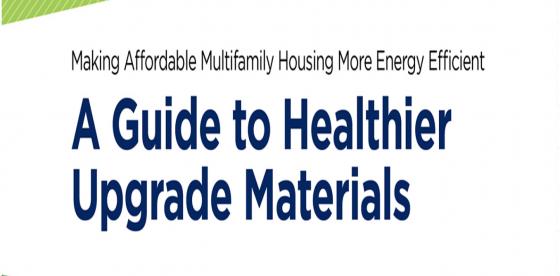Green Building Community
Making Affordable Multifamily Housing More Energy Efficient- a Guide to Healthier Upgrade Materials
Posted by: ella.nielsen44 // Student

A group of organizations including Energy Efficiency for All and The Healthy Building Network released a significant report in September, 2018, “Making Affordable Multifamily Housing More Energy Efficient: a Guide to Healthier Upgrade Materials,” to discuss the benefits and recommendations regarding the materials commonly used in in energy efficient upgrades for affordable households and buildings, with a particular focus on insulating and air sealing. Clearly, it makes sense for both owners and residents to save energy and money investing in property upgrades. But sometimes these well intended efforts also bring about harmful unintended consequences. This guide is intended for people who are deciding what products are the most energy efficient and least impactful health, including the health of those who dwell in buildings of course, but also those who manufacture, install, and deinstall these materials, as well as neighboring residents and communities, and the planet at large. The good news is that there are increasing numbers of healthier insulation and air-sealing materials available, often at competitive prices. A concern is that too few people and companies are currently informed enough to make informed health choices. The message is that with more care and information like the type impressively assembled in this report, we can meet the goals of improving these building, saving money, improving health, and preserving our environment.
The guide focuses on affordable multifamily rental stock, which can be substandard and poorly maintained, with disproportionate utility expenses and health risks. There is a significant amount of evidence that demonstrates that improvements such as weatherizing these structures can improve the residents’ health by reducing factors such as: asthma symptoms and thermal stress – which also relate to lowering energy costs. The problem with most insulation and air-sealing materials is that they produce chemical emissions which can endanger the residents and the actual structure as well. The report describes the health effects of long-term exposure to hazardous insulation and air sealing products. For example, the most prevalent chemicals found in these products are halogenated flame retardants, formaldehyde-based binders, isocyanates, and phthalate plasticizers. Health effects can range from asthma to reproductive and development impacts.
“Making Affordable Multifamily Housing More Energy Efficient: a Guide to Healthier Upgrade Materials,” presents 5 top recommendations for ensuring healthy materials in affordable housing energy efficiency work that are worth sharing here, but for more information, it is worth reviewing the entire report. Other topics covered include understanding the challenges to wider adoption, specific recommendations for insulation and air sealing materials by type (though not down to specific product or brand), and some key ideas about wider engagement. While the focus is on affordable housing, clearly there are implications for the entire building industry.
Top recommendations for ensuring healthy materials in affordable housing energy efficiency work:
- Improving the transparency of the chemical content of upgrade materials
- Investing in product innovation, demonstrations, and early adopters to mainstream and scale the use of healthier products
- Using state and local policy tools like the LowIncome Housing Tax Credit’s allocation priorities to drive healthier upgrade materials usage
- Ensuring that the upgrade workforce is appropriately trained to use these healthier materials
- Engaging in wider and strategic industry dialogue to begin the complex process of forging consensus about the need to use healthier materials to achieve energy efficiency
This last point is critical and can even refer back to awareness about this report itself. We must all work to share and promote this kind of valuable information, and to expand the number of people and organizations who even know about these issues, and who can contribute to making all buildings both sustainable and healthy buildings. Leaky windows make no sense. But as we fix one problem, we must be careful to do better by the people and planet we’re aiming to serve, and not cause another problem, particularly a health problem. How many people working on buildings and selecting these products know about these harmful chemicals? How many feel informed and empowered to make more sustainable and healthy choices? How can we increase these numbers?
The report also provides top ideas for engaging stakeholders for ensuring healthier energy efficiency upgrades:
- Engage manufacturers to provide greater transparency
- Support product development to bring healthier products to market with the intent of quickly achieving scale
- Invest in wider building industry dialogue and consensus building
- Influence state and local policy in the affordable multifamily development sector
- Ensure appropriate workforce development
Research like that embodied in this guide is critical for taking the next positive sustainability and health steps for this population as well as for all buildings, as is a great collaborative effort among all building industry participants. Until every stakeholder and decision maker have access and knowledge of this information at the appropriate level and know what questions to ask when more information is needed, the job isn’t done well enough.
To learn more, and to download the guide:
http://www.energyefficiencyforall.org/resources/making-affordable-multifamily-housing-more-energy-efficient-guide-healthier-upgrade
Matt Hoots // SawHorse Design + Build
Unless we engage in forums like this and talk specifically about the products we use, then it is up to the manufacturers to promote. They are going to promote based on what they think the end user wants. It took decades for us to educate the consumer about VOC's so some binders such as formaldehyde are no longer used in insulation. Education and peer pressure are strong market forces. If the consumer does not care then change will not happen.
In the meantime, we need to support green manufactures such as the ones on this site so they weather the storm as we are trying to make these changes in the industry. The green building techniques that I was introducing 20 years ago are code today so the market does catch up eventually. Just takes time and energy.
Please be kind and respectful!
Please make sure to be respectful of the organizations and companies, and other Rate It Green members that make up our community. We welcome praise and advice and even criticism but all posted content and ratings should be constructive in nature. For guidance on what constitutes suitable content on the Rate It Green site, please refer to the User Agreement and Site Rules.
The opinions, comments, ratings and all content posted by member on the Rate It Green website are the comments and opinions of the individual members who posts them only and do not necessarily reflect the views or policies or policies of Rate It Green. Rate It Green Team Members will monitor posted content for unsuitable content, but we also ask for the participation of community members in helping to keep the site a comfortable and open public forum of ideas. Please email all questions and concerns to admin@rateitgreen.com


